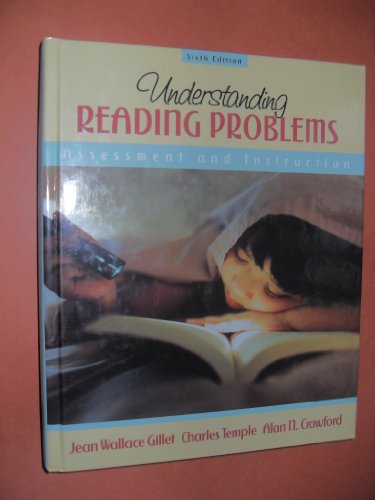
Synopsis
This market-leading text has been heavily revised while maintaining its focus on struggling readers and emphasizing classroom-based, teacher-driven approaches to assessment and remediation. Understanding Reading Problems, 6/e, integrates authentic vignettes and case studies and clear, vivid writing with the latest research. Expanded coverage of portfolio assessment, lexiles and guided reading levels, running records and other informal observation procedures, developmental spelling stages, emergent literacy assessments, assessing and teaching students with limited English proficiency, and practical strategies for adapting instruction for special-needs students in inclusion classrooms make the 6th edition the foremost text in its field.
"synopsis" may belong to another edition of this title.
From the Back Cover
Ringing Endorsements for Scaffolding Emergent Literacy…
“Readers simply love this book because of the perfect balance of theory and practice.”
Professor Nancy Hansen-Krening, University of Washington
¦-------------------------------------------------------------------------¦ “I found the book compelling, sound, and researched with a strong application element: theory to practice.”
Professor Verlinda Angell, Southern Utah University
¦-------------------------------------------------------------------------¦ “My students like the massive amount of information contained in a relatively short text. The organization has a nice flow and fits well with the syllabus.”
Professor Vi Austin, Stephen F. Austin State University
¦-------------------------------------------------------------------------¦ Scaffolding Emergent Literacy will help children become more strategic in their building of literacy skills and concepts!
Underscored by rich child development theory, developmentally appropriate practices, and sound research, the Second Edition of this popular book is packed with literacy activities that support emergent to fluent literacy. Each strategy is paired with a classroom demonstration and samples of children's work. With this book, assessment isn't an afterthought! Scaffolding Emergent Literacy provides in-depth coverage of highly effective assessment and evaluation strategies and offers numerous classroom-based, child-centered measurement tools, along with useful descriptions of the most common standardized tests being used for diagnostic purposes.
New To The Second Edition
- New coverage of Special Education!
- Strategies for English Language Learners throughout!
- New activities with information on the use of technology in the classroom!
- New activities through Grade 5!
For information on related books by Allyn & Bacon, visit www.ablongman.com/edresources.
"About this title" may belong to another edition of this title.
Search results for Understanding Reading Problems: Assessment and Instruction...
Understanding Reading Problems: Assessment and Instruction (6th Edition)
Seller: World of Books (was SecondSale), Montgomery, IL, U.S.A.
Condition: Very Good. Item in very good condition! Textbooks may not include supplemental items i.e. CDs, access codes etc. Seller Inventory # 00090839637
Understanding Reading Problems: Assessment and Instruction (6th Edition)
Seller: ThriftBooks-Dallas, Dallas, TX, U.S.A.
Hardcover. Condition: Fair. No Jacket. Readable copy. Pages may have considerable notes/highlighting. ~ ThriftBooks: Read More, Spend Less. Seller Inventory # G0205386423I5N00
Understanding Reading Problems: Assessment and Instruction (6th Edition)
Seller: ThriftBooks-Atlanta, AUSTELL, GA, U.S.A.
Hardcover. Condition: As New. No Jacket. Pages are clean and are not marred by notes or folds of any kind. ~ ThriftBooks: Read More, Spend Less. Seller Inventory # G0205386423I2N00
Understanding Reading Problems: Assessment and Instruction (6th E
Seller: Hawking Books, Edgewood, TX, U.S.A.
Condition: Good. Meets or exceeds the good condition guidelines. Nice copy. Has a small amount of writing/highlighting. Five star seller - Buy with confidence! Seller Inventory # X0205386423X3
Understanding Reading Problems: Assessment and Instruction (6th Edition)
Seller: Wonder Book, Frederick, MD, U.S.A.
Condition: Good. Good condition. 6th edition. A copy that has been read but remains intact. May contain markings such as bookplates, stamps, limited notes and highlighting, or a few light stains. Seller Inventory # D16L-01176
Understanding Reading Problems : Assessment and Instruction
Seller: Better World Books, Mishawaka, IN, U.S.A.
Condition: Good. 6th. Used book that is in clean, average condition without any missing pages. Seller Inventory # 3151274-6
Understanding Reading Problems: Assessment and Instruction (6th Edition)
Seller: BennettBooksLtd, San Diego, NV, U.S.A.
hardcover. Condition: New. In shrink wrap. Looks like an interesting title! Seller Inventory # Q-0205386423
Understanding Reading Problems: Assessment and Instruction
Seller: Revaluation Books, Exeter, United Kingdom
Hardcover. Condition: Brand New. 6th sub edition. 512 pages. 9.25x7.50x1.00 inches. In Stock. Seller Inventory # 0205386423
Buy New
Quantity: 1 available
